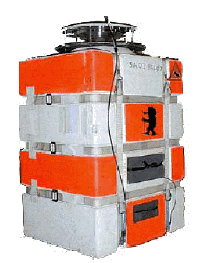Purpose of the flight and payload description
SAOZ is a UV-visible spectrometer able to provide vertical profiles of O3, NO2, OClO, BrO and H2O by solar occultation during ascent of the balloon (or descent) and from float at 30 km during sunset (or sunrise). The balloon version of the SAOZ instrument is very similar to the one used for ground-based measurements of total ozone and NO2.
It is composed by a commercial flat field, 360mm, holographic grating spectrometer equipped with a 1024-diode linear array and an entrance slit of 50 µm. A simple conical mirror replaces the gondola orientation or sun tracker systems generally used on large balloon platforms and is driven by an on-board computer, connected to a PTU (Pressure, Temperature and Humidity) sensor, a GPS (Global Positioning system ) for the localisation (Altitude, latitude and longitude) and an Argos transmitter for the recovery of the payload after cut-down and descent under parachute.
At left can be seen a picture of the standard package. The weight of the instrument is about 20 Kg and is contained in a insulated box with only a small aperture in the top for capture the solar rays. It's currently flown in three configurations, SaOZ-Standard, SAOZ-BrO and SAOZ-H2O each tuned to a different wavelength for measurements of different atmospheric constituents.
Details of the balloon flight
Balloon launched on: 3/2/1998 at V
Launch site: Andoya Rocket Range, Nordland, Norway
Balloon launched by: Centre National d'Etudes Spatiales (CNES)
Balloon manufacturer/size/composition: Zero Pressure Balloon
End of flight (L for landing time, W for last contact, otherwise termination time): 3/2/1998
External references
- SAOZ balloon program Service d'Aéronomie, Centre National de la Recherche Scientifique
- Climatology of the stratospheric BrO vertical distribution by balloon-borne UV-visible spectrometry Journal of Geophysical Research (Atmospheres), Volume 107, Issue D24, pp. ACH 23-1
78If you consider this website interesting or useful, you can help me to keep it up and running with a small donation to cover the operational costs. Just the equivalent of the price of a cup of coffee helps a lot.


